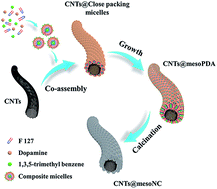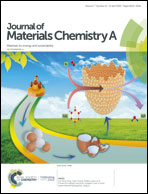Synthesis of carbon nanotubes@mesoporous carbon core–shell structured electrocatalysts via a molecule-mediated interfacial co-assembly strategy†
Abstract
Core–shell structured mesoporous materials have received great interest for various applications. However, it remains a great challenge to coat mesoporous carbon shells with large accessible pores and short tubular channels due to the difficulty in controlling the interfacial interactions during the co-assembly process. Herein, uniform carbon nanotubes@mesoporous N-doped carbon (CNTs@mesoNC) core–shell structured nanofibers are synthesized by a molecule-mediated interfacial co-assembly strategy. The interaction between F127 and polydopamine can be well mediated by 1,3,5-trimethyl benzene molecules, thus enabling the formation of composited micelles and ensuring the interfacial co-assembly on the CNT surface. Such a strategy is very simple and versatile for synthesis of various mesoporous carbon-based core–shell structures. The obtained CNTs@mesoNC nanofibers possess highly conductive CNT cores, ultrathin shell thickness (∼28 nm), perpendicular mesopores (∼6.9 nm) in the shell, high surface area (∼768 m2 g−1), and abundant N-doping sites (6.9 at%), which distinguish them from bulk mesoporous carbons with small pore sizes. As a result, the nanofibers exhibit superior electrocatalytic performance toward the oxygen reduction reaction in alkaline media. This method paves a way to design functional core–shell materials with uniform mesoporous carbon shells for potential applications in adsorption, catalysis and energy fields.



 Please wait while we load your content...
Please wait while we load your content...